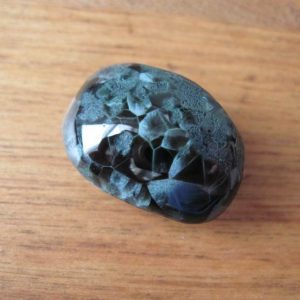Chlorastrolite
Chlorastrolite, also called Greenstone or Green Starstone, is really a variety that is unusual of) that was first discovered at Isle Royale, Lake Superior, Michigan, USA by C. T. Jackson and J. D. Whitney in 1847. Chlorastrolite was once thought to be an variety that is impure of or Thomsonite. Gorgeous dark green Chlorastrolie cabochons exhibit chatoyancy in a mosaic that is distinctive segmented pattern often referred to as “turtleback” because of its similarity to the pattern on a turtle shell. The colors of Chlorastrolite resemble fine Emerald or Imperial Jade. Chlorastrolite is the consistant state gemstone of Michigan.
| Chemical Formula: | Ca2MgAl2(SiO4)(Si2O7)(OH)2 • (H2O) |
| Hydrated Calcium Magnesium Silicate Hydroxide | |
| Molecular Weight: | 470.70 gm |
| Composition: | Calcium | 17.03 % | Ca | 23.83 % | CaO |
| Magnesium | 5.16 % | Mg | 8.56 % | MgO | |
| Aluminum | 11.46 % | Al | 21.66 % | Al2O3 | |
| Silicon | 17.90 % | Si | 38.29 % | SiO2 | |
| Hydrogen | 0.86 % | H | 7.65 % | H2O | |
| Oxygen | 47.39 % | O | |||
| 100.00 % | 100.00 % | = TOTAL OXIDE |
| Crystallography: | Monoclinic – Prismatic |
| Crystal Habit: | Crystals are fibrous, flattened plates in clusters or dense mats or random fibers. |
| Twinning: | Rarely |
| Cleavage: | No cleavage in massive material |
| Fracture: | Splintery (massive material); Subconchoidal |
| Tenacity: | Brittle |
| Moh’s Hardness: | 5.0 – 6.0 |
| Density: | 3.10 – 3.50 (g/cm3) |
| Luminescence: | None |
| Radioactivity: | Not Radioactive |
| Color: | Green, Bluish Green, Greenish Black, Brown; Colorless, Green, Yellow, Brown in thin section. |
| Transparency: | Translucent, Opaque |
| Luster: | Vitreous (glassy) |
| Refractive Index: | 1.674 – 1.722 Biaxial ( + ) and ( – ) |
| Birefringence: | 0.0140 – 0.0220 |
| Dispersion: | Relatively Strong; r < v (less commonly r > v) |
| Pleochroism: | Strong; X = nearly colorless to pale greenish yellow; Y = blue-green; Z = almost colorless to brownish yellow. |


